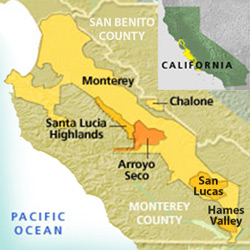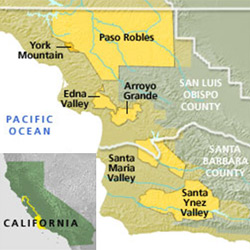The Wines of the California Coast
Growing Regions
The vast Central Coast is home to more than 30 sub-appellations, each with distinct characteristics.
California's Central Coast links 250 miles of coastline vineyard into one vast American Viticulture Area (AVA). Spanning 30 sub-AVA's, the region's 100,000 acres of vineyard share a common thread: the West Coast marine effect, which moderates warm temperatures during the growing season. Yet each vineyard represents dramatic differences in climate and soil, stitching together an incredibly diverse wine map.
At the north end of the Central Coast, the San Francisco Bay AVA is heavily influenced by coastal fog and produces mostly Chardonnay, Cabernet Sauvignon and Merlot. Traveling south, Monterey County enjoys a long-growing season due to its cool, foggy climate, and is home to some of California's most sought-after Chardonnays. Monterey County is one of the state's larger AVAs, with nine sub-regions, including the renowned Santa Lucia Highlands appellation, where grapes are produced which result in incredible Pinot Noir and Chardonnay wines.
Diverse climate is a hallmark of the southernmost districts in the Central Coast AVA – San Luis Obispo and Santa Barbara counties – where vineyards vary dramatically in their proximity to the ocean and their elevation. The warmer inland sub-regions of San Luis Obispo, like Paso Robles and Santa Ynez Valley, are famous for complex Syrah.
Central Coast
California’s Central Coast American Viticulture Area (AVA) covers a vast area, including 30 sub-AVA’s. Stretching down the Pacific Coast for 250 miles from San Francisco Bay to Santa Barbara, the region produces 15% of California’s winegrapes and is home to more than 350 wineries. The area’s ocean influence and unusual configuration of bays, mountains and valleys create a variety of growing conditions. Warm days and cool nights are the norm over much of the region.
Key areas include Monterey County, its sub-AVA of Santa Lucia Highlands, Paso Robles in San Luis Obispo County and the Santa Ynez Valley to the south.
Monterey County
Monterey County encompasses nine AVAs and 40,000 acres of vineyards. The area sees a great deal of sun and very little rain, resulting in a long growing season. Monterey Bay on the Pacific funnels in cooling ocean influences, including periodic morning and evening fogs. The result is a long, slow, growing and ripening process that results in smaller grape berries with concentrated flavors. Chardonnay and Pinot Noir lead production, with Riesling, Merlot, Syrah and some Cabernet Sauvignon.
Santa Lucia Highlands
The Santa Lucia Highlands AVA comprises a long narrow strip of land in upper Monterey County on the western edge of the Salinas River. The AVA has a decidedly cool climate, both because of the coastal ocean influence and because of its generally high elevation, over 2,000 feet in some areas. The crests of the mountains between the Highlands and the ocean create a “rain shadow,” resulting in no more than 12” of rain annually. Strong afternoon winds swerve to keep the climate cool and avoid large temperature fluctuations.
Paso Robles
Occupying a large region around the city of Paso Robles in Northern San Luis Obispo County, the Paso Robles AVA is extremely varied, producing more than 40 different winegrape varieties on 26,000 acres of vineyards. The AVA is known for substantial day-tonight temperature swings and long, rain-free harvest seasons. Vineyards are located at a range of elevations from 700 to about 2,000 feet above sea level.
Santa Ynez Valley
The Santa Ynez Valley, home to Bridlewood Estate Winery, achieved renown with the popularity of the film Sideways. The valley occupies an unusual east-west corridor; and nearly the entire region enjoys cooling ocean influence at night. The result is a wide variety of vineyard sites, with Pinot Noir and Chardonnay flourishing in the Santa Rita Hills to the west, and Bordeaux and Rhone varietals in the warmer areas further to the east. Approximately 2,000 acres are planted to vine.
*An American Viticultural Area (AVA) is a designated wine grape-growing region in the United States distinguishable by geographic features, with boundaries defined by the Alcohol and Tobacco Tax and Trade Bureau (TTB), United States Department of the Treasury

